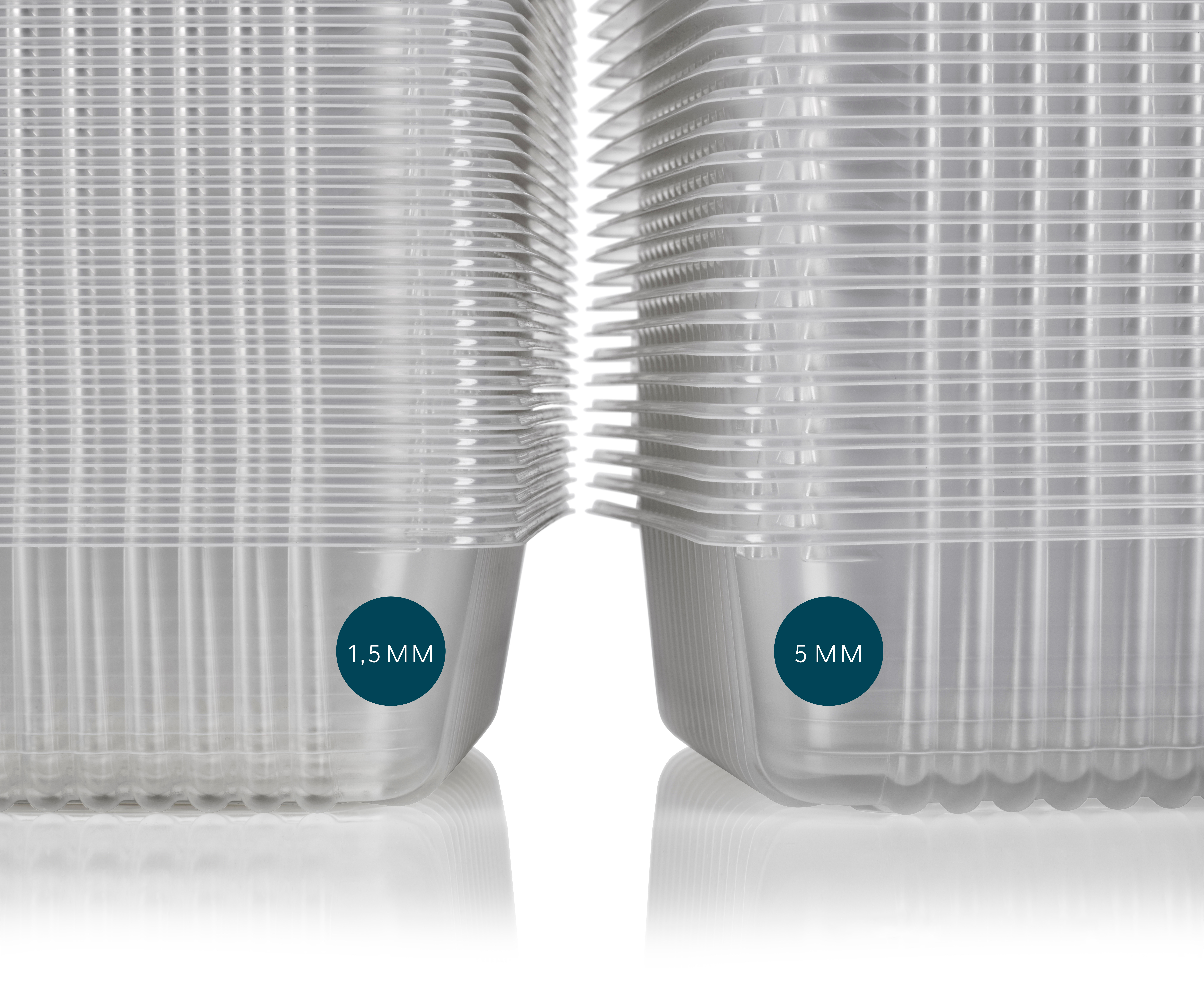Push the Limits With 67% Less: Maximize Results While Minimizing Emissions
Introducing: Faerch’s Patented Ultra Low Stacking Trays Made in Partnership with QUPAQ and Norfersk
ENHANCING SUSTAINABILITY
When Millimeters
Makes the Difference
In a time marked by a focus on innovation, precision, reliability, automation, and sustainability within the food industry, a partnership between two industry leaders has led to a revelation: Faerch’s patented Ultra Low Stacking trays. Achieving up to 67% space savings during transport, storage, and handling, whilst achieving a tray denesting success rate of 99.96%, these trays deliver exceptional results.
Unlocking 67% Space Savings
At the heart of the Ultra Low Stacking tray’s innovation lies the noteworthy 1.5 mm gap between each tray, a significant contrast to the 3-6 mm gap found in traditional trays. An intricate stacking configuration that required an adaptable and precise tray denesting solution. A challenge that could only be solved through close collaboration between tray manufacturer and tray denesting manufacturer.
Norfersk Overview:
- Norfersk is a wholly owned subsidiary of Nortura SA, an agricultural cooperative owned by 19,000 farmers across Norway.
- Norfersk annually produces approximately 20 million kilograms of meat.
- The company boasts more than 140 employees and generates an annual turnover of approximately 2 billion NOK.
- Norfersk is recognized as one of Norway’s largest meat producers.

How It Started: Engineering a Collaborative Approach
In 2020 Norwegian Norfersk needed to transition to a new type of tray to meet their environmental sustainability goals. They decided to switch from PP to PET made from 99% recycled content and fully recyclable. Rasmus Haage Sørensen, Project Manager at Norfersk, said:
“Like the rest of the world, we have a desire to do what we can to preserve our raw materials as long as possible and contribute to a global goal of recycling as much plastic as possible. In addition, we needed to find a way to reduce our emissions by transporting more trays per truck.”
To ensure optimal performance, reduced space, and delivery costs for Norfersk, the collaborative effort between Faerch and QUPAQ was established. The goal was to develop a low-stack tray in PET, that was designed to be compatible with a denesting tool, accommodating trays of varying heights to ensure smooth transitions. Several meetings, drawings, and discussions later, the Ultra Low Stacking trays were finally created as the perfect combination and fit for Norfersk’s production. With the use of QUPAQ’s INTRAY Buffer Servo denester, calibrated to accommodate these trays, Norfersk achieved a reliable production line with an extraordinary tray denesting success rate of 99.96%.
Optimizing Operational Uptime
Considering the impressive tray denesting success rate of 99.96%, it’s worth noting that even the rarest denesting errors are automatically rectified by the INTRAY Buffer Servo’s smart auto-correct feature. This ensures impeccable production uptime with no production stops, showcasing the system’s remarkable reliability.
A Sustainable Paradigm Shift
The Ultra Low Stacking trays did not only meet Norfersk’s need for a tray that matched an adaptable production while being made from recycled material, but it was also proof that innovation and sustainability are intertwined ideals – something the Ultra Low Stacking trays both deliver on.
Highlighting up to 67% space savings during transport, transit packaging, storage, and handling, these trays translate to significantly reduced CO2 emissions — a testament to Faerch and QUPAQ’s commitment to crafting solutions that excel across multiple dimensions. Simply: less is more.
Norfersk’s Achievements
After more than three years in production, Norfersk highlights the following achievements resulting from the synergy of Faerch’s Ultra Low Stacking trays and QUPAQ’s INTRAY Buffer Servo:
- A 99.96% denesting success rate, resounding in exceptional uptime.
- Approximately a 67% reduction in transport, handling, and storage requirements, resulting in significantly lower CO2 emissions.
- A substantial reduction in maintenance costs has been saved compared to the years before.
- Smooth transitions between trays with different heights with no need to switch tools.
- More than 38 million trays denested since the implementation.
The Future of Packaging
In essence, Faerch and QUPAQ developed a match between the trays and the tray denester, resulting in resounding success at Norfersk. With more than 38 million trays denested at Norfersk, the Ultra Low Stacking trays serve as a proof that innovation flourishes in environments where complementary competencies come together to produce results greater than the sum of their parts. Rasmus Haage Sørensen’s statement encapsulates this achievement:
“Now the big question is whether the investment can pay off, and the answer is simple: yes, it can. The amount of money invested in this project pales in comparison to the returns we’ve seen.”
In summary, this collaboration did not only redefine what’s achievable in terms of functionality, but it also showcased the importance of the dance of millimeters that contributes to a brighter, more efficient, and sustainable future within the packaging solution.

About Faerch
Faerch is a leading supplier of circular, rigid food packaging and with integrated recycling capability. We serve food manufacturers and retailers around the world with our network of state-of-the-art production facilities across Europe.
Faerch supply food manufacturers, food retailers, food service providers, and airlines with food packaging solutions designed to optimize their production flow, supply chain and total cost of ownership.
Visit faerch.com
About QUPAQ
QUPAQ stands as the global leader of tray denesting technology, delivering automated solutions that revolutionize tray handling, providing operational efficiency and added value to businesses across the globe. QUPAQ’s denesting systems are highlighted by quality and precision, ensuring both reliability and efficiency.
The mission in pioneering these technologies and innovation, is consistently pushing the boundaries of what’s possible in automating production lines.




